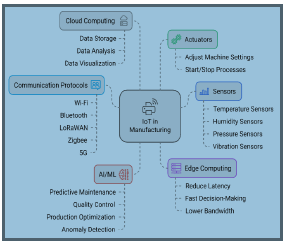
Downloads
IoT and Edge Computing for Smart Manufacturing: Architecture and Future Trends
Authors
Abstract
The integration of the Internet of Things (IoT) and Edge Computing is revolutionizing the manufacturing industry, ushering in the era of smart manufacturing as part of Industry 4.0. This paper explores the synergy between IoT and Edge Computing, focusing on their combined architecture and the future trends driving innovation in smart factories. IoT enables the connection and communication of machines, sensors, and systems, allowing for real-time data collection and monitoring. However, traditional cloud-based approaches face challenges such as latency, bandwidth limitations, and security risks, which can hinder real-time decision-making in fast-paced manufacturing environments. Edge Computing addresses these issues by processing data closer to the source, minimizing latency and reducing dependence on cloud infrastructures. By combining IoT and edge solutions, smart manufacturing systems can make faster, data-driven decisions, leading to improved efficiency, reliability, and operational flexibility. This paper delves into the architectural design of IoT and edge computing in manufacturing, outlining how data flows from IoT devices to edge nodes and cloud services. Several real-world use cases and industry examples are analyzed to highlight the practical benefits of these technologies.
Additionally, this research identifies key challenges such as security vulnerabilities, the need for robust network infrastructures (e.g., 5G), and issues related to data standardization. The future of smart manufacturing is also explored, emphasizing trends like the adoption of artificial intelligence (AI) and machine learning (ML) at the edge, digital twins for real-time monitoring, and the role of IoT and edge computing in fostering sustainability through energy-efficient production processes.This study provides a comprehensive overview of IoT and edge computing architectures in smart manufacturing and offers insights into future technological trends that will shape the industry.
Article Details
Published
Issue
Section
License

This work is licensed under a Creative Commons Attribution-NonCommercial-ShareAlike 4.0 International License.

